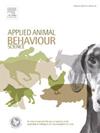Interspecific oral rabies vaccine bait competition in the Southeast United States
Abstract
The United States Department of Agriculture’s National Rabies Management Program (NRMP) has coordinated the use of oral rabies vaccination (ORV) to control the spread of raccoon rabies virus variant west of the Appalachian Mountains since 1997. Working with state and local partners, the NRMP deploys ORV baits containing a rabies vaccine, primarily targeting raccoon populations (Procyon lotor). Bait competition between raccoons and non-target species may limit the effectiveness of ORV programs, but the extent of bait competition remains poorly quantified, particularly in the southeastern United States. We placed placebo ORV baits in bottomland hardwood (n = 637 baits) and upland pine (n = 681 baits) habitats in South Carolina, USA during August-December 2019 and used remote cameras to examine bait competition between raccoons and non-target species. The estimated proportion of bait consumed by raccoons was 18.8 ± 2.1% in bottomland hardwood and 11.6 ± 2.1% in upland pine habitats. Vertebrate competition appeared to have a minimal effect on raccoon uptake as estimated consumption did not exceed 5% for any species or 8% of bait uptake events cumulatively. We estimated that raccoons were the primary consumer of baits in bottomland hardwood, whereas invertebrates were the primary consumer in upland pine (26.7 ± 1.3% of baits). Our results indicate a need to closely consider the effects of invertebrates on bait consumption to minimize their potential impact on ORV bait uptake by target species. Uptake probabilities by raccoons were relatively low but not primarily driven by competition with vertebrates. As such, strategies to increase the specificity of raccoon uptake may be needed to enhance the effectiveness of ORV baiting programs.

 求助内容:
求助内容: 应助结果提醒方式:
应助结果提醒方式:


